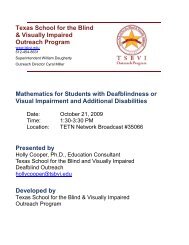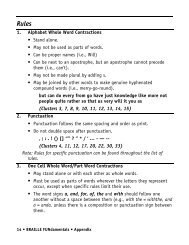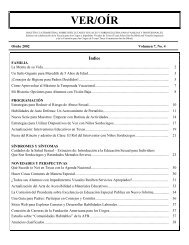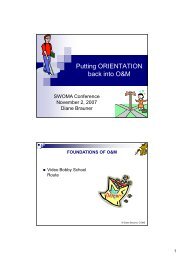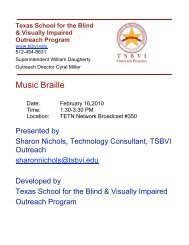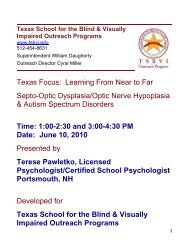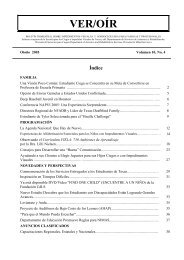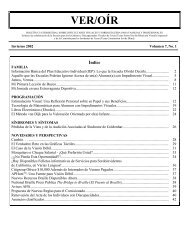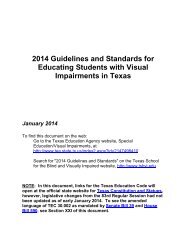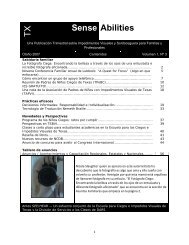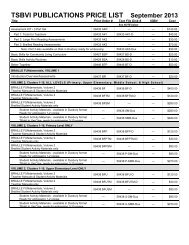Intervener Portfolio Summary - PDF - Texas School for the Blind and ...
Intervener Portfolio Summary - PDF - Texas School for the Blind and ...
Intervener Portfolio Summary - PDF - Texas School for the Blind and ...
Create successful ePaper yourself
Turn your PDF publications into a flip-book with our unique Google optimized e-Paper software.
<strong>Intervener</strong> <strong>Portfolio</strong> <strong>Summary</strong><br />
<strong>Intervener</strong>’s Name: ______________________________ <strong>School</strong> District: _________________________<br />
Instructions:<br />
Student’s Initials: _____<br />
1. After you get training in any of <strong>the</strong> competencies below, please enter <strong>the</strong> month <strong>and</strong> year you received training in <strong>the</strong> columns<br />
to <strong>the</strong> right of <strong>the</strong> item. Mark at least one “Method of Learning” <strong>and</strong> at least one “Type of Documentation”.<br />
2. The st<strong>and</strong>ards included in this revised portfolio document have been reorganized to comply with approved CEC st<strong>and</strong>ards. The<br />
number found paren<strong>the</strong>ses at <strong>the</strong> end of each competency refer to <strong>the</strong> item number from <strong>Intervener</strong> <strong>Portfolio</strong>s prior to this 2009<br />
revision, <strong>and</strong> may be used to cross-reference current items to competencies in older editions.<br />
3. If you haven’t received training in a competency yet, leave <strong>the</strong> columns to <strong>the</strong> right of that competency blank.<br />
4. Place <strong>the</strong> actual documentation in your portfolio.<br />
<strong>Intervener</strong> Competency St<strong>and</strong>ards Methods of Learning Types of Documentation<br />
Section 1:<br />
Foundational knowledge<br />
Competencies<br />
The <strong>Intervener</strong> demonstrates knowledge of:<br />
SEP1K1 Purposes of programs <strong>for</strong> individuals with exceptional learning needs<br />
Workshop/Conference<br />
On-site Consultation/<br />
On <strong>the</strong> Job Training<br />
Self-Study<br />
College Coursework<br />
Certificate<br />
Written Document<br />
Work Evaluation<br />
Student/<strong>Intervener</strong><br />
Work Sample<br />
Video or Photos of Work<br />
SEP1K2 Basic educational terminology regarding individuals with exceptional<br />
learning needs, programs, roles, <strong>and</strong> instructional activities<br />
DBI1K1 Definition of deafblindness (1.1)<br />
DBI1K2Differences between congenital <strong>and</strong> acquired deafblindness (1.3)<br />
DBI1K3 Implications of <strong>the</strong> age of onset of vision <strong>and</strong> hearing loss, <strong>the</strong> types<br />
<strong>and</strong> degrees of loss, <strong>and</strong> <strong>the</strong> presence of additional disabilities on<br />
development <strong>and</strong> learning (1.6)<br />
DBI1K5 Anatomy <strong>and</strong> function of <strong>the</strong> eyes <strong>and</strong> ears (5.2)<br />
May 2009 Revision based on CEC <strong>Intervener</strong> St<strong>and</strong>ards <strong>Texas</strong> Deafblind Project http://www.tsbvi.edu/Outreach/deafblind/index.htm 1
<strong>Intervener</strong> Competency St<strong>and</strong>ards Methods of Learning Types of Documentation<br />
St<strong>and</strong>ard 2:<br />
Development <strong>and</strong> Characteristics of Learners<br />
Competencies<br />
The <strong>Intervener</strong> demonstrates knowledge of:<br />
SEP2K1 Effects an exceptional condition(s) can have on an individual’s life<br />
Workshop/Conference<br />
On-site Consultation/<br />
On <strong>the</strong> Job Training<br />
Self-Study<br />
College Coursework<br />
Certificate<br />
Written Document<br />
Work Evaluation<br />
Student/<strong>Intervener</strong><br />
Work Sample<br />
Video or Photos of Work<br />
DBI2K1 Impact of combined vision <strong>and</strong> hearing loss on development <strong>and</strong><br />
learning (1.2, 1.10c)<br />
DBI2K2 Differences between concept development <strong>and</strong> skill development, <strong>and</strong><br />
<strong>the</strong> impact of deafblindness on each (1.4)<br />
DBI2K3 Process of intervention <strong>for</strong> individuals with deafblindness (2.1)<br />
DBI2K4 Impact of deafblindness on bonding, attachment, <strong>and</strong> social interaction<br />
(4.1)<br />
DBI2K5 Impact of deafblindness on psychological development <strong>and</strong> on <strong>the</strong><br />
development of self identity (4.3)<br />
DBI2K6 Impact of deafblindness related to isolation, stress, <strong>and</strong> vulnerability<br />
(4.4)<br />
DBI2K7 Impact of deafblindness on aspects of sexuality (4.5)<br />
DBI2K8 Impact of additional disabilities on individuals with deafblindness (7.1)<br />
DBI2K9 Brain development <strong>and</strong> <strong>the</strong> neurological implications of combined vision<br />
<strong>and</strong> hearing loss (7.2)<br />
May 2009 Revision based on CEC <strong>Intervener</strong> St<strong>and</strong>ards <strong>Texas</strong> Deafblind Project http://www.tsbvi.edu/Outreach/deafblind/index.htm 2
<strong>Intervener</strong> Competency St<strong>and</strong>ards Methods of Learning Types of Documentation<br />
St<strong>and</strong>ard 3:<br />
Individual Learning Differences<br />
Competencies<br />
The <strong>Intervener</strong> demonstrates knowledge of:<br />
SEP3K1 Rights <strong>and</strong> responsibilities of families <strong>and</strong> children as <strong>the</strong>y relate to<br />
individual learning needs<br />
SEP3K2 Indicators of abuse <strong>and</strong> neglect<br />
Workshop/Conference<br />
On-site Consultation/<br />
On <strong>the</strong> Job Training<br />
Self-Study<br />
College Coursework<br />
Certificate<br />
Written Document<br />
Work Evaluation<br />
Student/<strong>Intervener</strong><br />
Work Sample<br />
Video or Photos of Work<br />
DBI3K1 Specific causes of <strong>the</strong> deafblindness (1.7c)<br />
DBI3K2 Strengths <strong>and</strong> needs of <strong>the</strong> individual (1.8c, 2.5)<br />
DBI3K3 Likes <strong>and</strong> dislikes of <strong>the</strong> individual (1.9c, 2.5)<br />
DBI3K4 Learning style <strong>and</strong> communication of <strong>the</strong> individual (1.10c, 2.5)<br />
DBI3K5 Audiological <strong>and</strong> ophthalmological conditions <strong>and</strong> functioning of <strong>the</strong><br />
individual (5.8c)<br />
DBI3K6 Additional disabilities of <strong>the</strong> individual, if present (7.3c)<br />
DBI3K7 Effects of additional disabilities on <strong>the</strong> individual, if present (7.4c)<br />
Competencies<br />
The <strong>Intervener</strong> demonstrates skill of:<br />
SEP3S1 Demonstrate sensitivity to <strong>the</strong> diversity of individuals <strong>and</strong> families<br />
DBI3S1 Facilitation of <strong>the</strong> individual’s underst<strong>and</strong>ing <strong>and</strong> development of<br />
concepts (1.11c)<br />
May 2009 Revision based on CEC <strong>Intervener</strong> St<strong>and</strong>ards <strong>Texas</strong> Deafblind Project http://www.tsbvi.edu/Outreach/deafblind/index.htm 3
<strong>Intervener</strong> Competency St<strong>and</strong>ards Methods of Learning Types of Documentation<br />
St<strong>and</strong>ard 4:<br />
Support of Instruction & Instructional Strategies<br />
Competencies<br />
The <strong>Intervener</strong> demonstrates knowledge of:<br />
SEP4K1 Basic instructional <strong>and</strong> remedial strategies <strong>and</strong> materials<br />
Workshop/Conference<br />
On-site Consultation/<br />
On <strong>the</strong> Job Training<br />
Self-Study<br />
College Coursework<br />
Certificate<br />
Written Document<br />
Work Evaluation<br />
Student/<strong>Intervener</strong><br />
Work Sample<br />
Video or Photos of Work<br />
SEP4K2 Basic technologies appropriate to individuals with<br />
exceptional learning needs<br />
DBI4K1 Strategies that promote visual <strong>and</strong> auditory development<br />
(5.5)<br />
DBI4K2 The use of calendar systems (3.5)<br />
Competencies<br />
The <strong>Intervener</strong> demonstrates skill to:<br />
SEP4S1 Use strategies, equipment, materials, <strong>and</strong> technologies, as<br />
directed, to accomplish instructional objectives<br />
SEP4S2 Assist in adapting instructional strategies <strong>and</strong> materials as<br />
directed<br />
SEP4S3 Use strategies as directed to facilitate effective integration<br />
into various settings<br />
SEP4S4 Use strategies that promote <strong>the</strong> learner’s independence as<br />
directed<br />
SEP4S5 Use strategies as directed to increase <strong>the</strong> individual’s<br />
independence <strong>and</strong> confidence<br />
DBI4S1 Provide one-on-one intervention (2.12c)<br />
DBI4S2 Use routines <strong>and</strong> functional activities as learning<br />
opportunities (2.4)<br />
DBI4S3 Facilitate direct learning experiences (2.7)<br />
May 2009 Revision based on CEC <strong>Intervener</strong> St<strong>and</strong>ards <strong>Texas</strong> Deafblind Project http://www.tsbvi.edu/Outreach/deafblind/index.htm 4
DBI4S4 Use techniques to increase anticipation, motivation,<br />
communication, <strong>and</strong> confirmation (2.8)<br />
May 2009 Revision based on CEC <strong>Intervener</strong> St<strong>and</strong>ards <strong>Texas</strong> Deafblind Project http://www.tsbvi.edu/Outreach/deafblind/index.htm 5
<strong>Intervener</strong> Competency St<strong>and</strong>ards Methods of Learning Types of Documentation<br />
St<strong>and</strong>ard 4:<br />
Support of Instruction & Instructional Strategies<br />
Workshop/Conference<br />
On-site Consultation/<br />
On <strong>the</strong> Job Training<br />
Self-Study<br />
College Coursework<br />
Certificate<br />
Written Document<br />
Work Evaluation<br />
Student/<strong>Intervener</strong><br />
Work Sample<br />
Video or Photos of Work<br />
Competencies<br />
The <strong>Intervener</strong> demonstrates skill to: (continued)<br />
DBI4S5 Facilitate interdependence <strong>for</strong> <strong>the</strong> individual (2.10, 2.11)<br />
DBI4S6 Vary <strong>the</strong> level <strong>and</strong> intensity of input <strong>and</strong> <strong>the</strong> pacing of<br />
activities (2.13c)<br />
DBI4S7 Adapt materials <strong>and</strong> activities to <strong>the</strong> individual’s needs, as<br />
directed (2.15)<br />
DBI4S8 Use strategies that provide opportunities to solve problems<br />
<strong>and</strong> to make decisions <strong>and</strong> choices (2.16c)<br />
DBI4S9 Implement intervention strategies <strong>for</strong> <strong>the</strong> individual’s daily<br />
care, self-help, transition, <strong>and</strong> job training (2.17c)<br />
DBI4S10 Use prescribed strategies to respond to <strong>the</strong> individual’s<br />
behavior (4.9c)<br />
DBI4S11 Provide <strong>the</strong> individual with opportunities <strong>for</strong> selfdetermination<br />
(4.10c)<br />
DBI4S12 Use touch to supplement auditory <strong>and</strong> visual input <strong>and</strong> to<br />
convey in<strong>for</strong>mation (5.11c)<br />
DBI4S13 Facilitate individual’s use of touch <strong>for</strong> learning <strong>and</strong><br />
interaction (5.1, 5.15c)<br />
DBI4S14 Facilitate individual’s use of <strong>the</strong> o<strong>the</strong>r senses to<br />
supplement learning modalities (5.7, 5.16c)<br />
May 2009 Revision based on CEC <strong>Intervener</strong> St<strong>and</strong>ards <strong>Texas</strong> Deafblind Project http://www.tsbvi.edu/Outreach/deafblind/index.htm 6
DBI4S15 Utilize strategies that support <strong>the</strong> development of body<br />
awareness, spatial relationships, <strong>and</strong> related concepts<br />
(6.7c, 6.10c)<br />
May 2009 Revision based on CEC <strong>Intervener</strong> St<strong>and</strong>ards <strong>Texas</strong> Deafblind Project http://www.tsbvi.edu/Outreach/deafblind/index.htm 7
<strong>Intervener</strong> Competency St<strong>and</strong>ards Methods of Learning Types of Documentation<br />
St<strong>and</strong>ard 4:<br />
Support of Instruction & Instructional Strategies<br />
Competencies<br />
The <strong>Intervener</strong> demonstrates skill to: (continued)<br />
Workshop/Conference<br />
On-site Consultation/<br />
On <strong>the</strong> Job Training<br />
Self-Study<br />
College Coursework<br />
Certificate<br />
Written Document<br />
Work Evaluation<br />
Student/<strong>Intervener</strong><br />
Work Sample<br />
Video or Photos of Work<br />
DBI4S16 Make adaptations <strong>for</strong> <strong>the</strong> cognitive <strong>and</strong> physical needs of<br />
<strong>the</strong> individual (7.6c)<br />
DBI4S17 Important adaptations consistent with <strong>the</strong> medical needs<br />
of <strong>the</strong> individual as directed (7.6c)<br />
DBI4S18 Utilize strategies to promote sensory integration<br />
(5.17c, 5.6)<br />
DBI4S19 Utilize strategies that promote independent <strong>and</strong> safe<br />
movement <strong>and</strong> active exploration of <strong>the</strong> environment<br />
(6.5c)<br />
DBI4S20 Implement positioning <strong>and</strong> h<strong>and</strong>ling as directed by <strong>the</strong><br />
OT/PT/O&M specialists (6.8c)<br />
DBI4S21 Promote <strong>the</strong> use of sighted guide, trailing, <strong>and</strong> protective<br />
techniques as directed by <strong>the</strong> O&M specialist (6.6c)<br />
DBI4S22 Implement strategies <strong>for</strong> travel as directed by an O&M<br />
specialist (6.11c)<br />
DBI4S23 Implement <strong>the</strong> use of mobility devices as directed by <strong>the</strong><br />
O&M specialist (6.9c)<br />
May 2009 Revision based on CEC <strong>Intervener</strong> St<strong>and</strong>ards <strong>Texas</strong> Deafblind Project http://www.tsbvi.edu/Outreach/deafblind/index.htm 8
<strong>Intervener</strong> Competency St<strong>and</strong>ards Methods of Learning Types of Documentation<br />
St<strong>and</strong>ard 5:<br />
Learning Environments & Social Interaction<br />
Competencies<br />
The <strong>Intervener</strong> demonstrates knowledge of:<br />
SEP5K1 Dem<strong>and</strong>s of various learning environments<br />
SEP5K2 Rules <strong>and</strong> procedural safeguards regarding <strong>the</strong> management<br />
of behaviors of individuals with exceptional learning needs<br />
Competencies<br />
The <strong>Intervener</strong> demonstrates <strong>the</strong> skill to:<br />
SEP5S1 Establish <strong>and</strong> maintain rapport with learners<br />
SEP5S2 Use universal precautions <strong>and</strong> assist in maintaining a safe,<br />
healthy learning environment<br />
SEP5S3 Use strategies <strong>for</strong> managing behavior as directed<br />
SEP5S4 Use strategies as directed, in a variety of settings, to assist in<br />
<strong>the</strong> development of social skills<br />
DBI5S1 Establish a trusting relationship with <strong>the</strong> individual (4.6c)<br />
DBI5S2 Provide an atmosphere of acceptance, safety, <strong>and</strong> security<br />
that is reliable <strong>and</strong> consistent <strong>for</strong> <strong>the</strong> individual (4.7c)<br />
DBI5S3 Promote positive self-esteem <strong>and</strong> well-being in <strong>the</strong><br />
individual (4.8c)<br />
DBI5S4 Promote social interactions <strong>and</strong> <strong>the</strong> development of<br />
meaningful relationships with an ever exp<strong>and</strong>ing number of<br />
people (3.18c, 3.21c, 4.11c)<br />
DBI5S5 Use <strong>and</strong> maintain amplification, cochlear implants, <strong>and</strong><br />
assistive listening devices as directed (5.9c)<br />
DBI5S6 Use <strong>and</strong> maintain glasses, low vision devices, <strong>and</strong> pros<strong>the</strong>ses<br />
as directed (5.10c)<br />
Workshop/Conference<br />
May 2009 Revision based on CEC <strong>Intervener</strong> St<strong>and</strong>ards <strong>Texas</strong> Deafblind Project http://www.tsbvi.edu/Outreach/deafblind/index.htm 9<br />
On-site Consultation/<br />
On <strong>the</strong> Job Training<br />
Self-Study<br />
College Coursework<br />
Certificate<br />
Written Document<br />
Work Evaluation<br />
Student/<strong>Intervener</strong><br />
Work Sample<br />
Video or Photos of Work
<strong>Intervener</strong> Competency St<strong>and</strong>ards Methods of Learning Types of Documentation<br />
St<strong>and</strong>ard 5:<br />
Learning Environments & Social Interaction<br />
Competencies<br />
The <strong>Intervener</strong> demonstrates skill to: (continued)<br />
Workshop/Conference<br />
On-site Consultation/<br />
On <strong>the</strong> Job Training<br />
Self-Study<br />
College Coursework<br />
Certificate<br />
Written Document<br />
Work Evaluation<br />
Student/<strong>Intervener</strong><br />
Work Sample<br />
Video or Photos of Work<br />
DBI5S7 Maximize <strong>the</strong> use of residual vision <strong>and</strong> hearing (5.12c)<br />
DBI5S8 Make adaptations <strong>for</strong> auditory needs as directed (5.13c)<br />
May 2009 Revision based on CEC <strong>Intervener</strong> St<strong>and</strong>ards <strong>Texas</strong> Deafblind Project http://www.tsbvi.edu/Outreach/deafblind/index.htm 10
<strong>Intervener</strong> Competency St<strong>and</strong>ards Methods of Learning Types of Documentation<br />
St<strong>and</strong>ard 6:<br />
Language<br />
Competencies<br />
The <strong>Intervener</strong> demonstrates knowledge of:<br />
SEP6K1 Characteristics of appropriate communication with stakeholders<br />
Workshop/Conference<br />
On-site Consultation/<br />
On <strong>the</strong> Job Training<br />
Self-Study<br />
College Coursework<br />
Certificate<br />
Written Document<br />
Work Evaluation<br />
Student/<strong>Intervener</strong><br />
Work Sample<br />
Video or Photos of Work<br />
DBI6K1 Basic communication development (3.1)<br />
DBI6K2 Impact of deafblindness on communication <strong>and</strong> interaction (3.2)<br />
DBI6K3 Modes/<strong>for</strong>ms of communication <strong>and</strong> devices used by individuals who<br />
are deafblind (3.4)<br />
Competencies<br />
The <strong>Intervener</strong> demonstrates <strong>the</strong> skill to:<br />
DBI6S1 Facilitate language <strong>and</strong> literacy development (3.6)<br />
DBI6S2 Observe <strong>and</strong> identify <strong>the</strong> communicative behaviors <strong>and</strong> intents (2.5, 3.7)<br />
DBI6S3 Implement methods <strong>and</strong> strategies <strong>for</strong> effectively conveying in<strong>for</strong>mation<br />
to <strong>the</strong> individual (3.8)<br />
DBI6S4 Respond to <strong>the</strong> individual’s attempts at communication (3.10)<br />
DBI6S5 Use communication techniques specific to <strong>the</strong> individual (3.9, 3.15c)<br />
DBI6S6 Incorporate/embed language <strong>and</strong> communication into all routines <strong>and</strong><br />
activities (2.6, 3.20c)<br />
DBI6S7 Use strategies <strong>for</strong> eliciting expressive communication (3.11, 3.13, 3.14)<br />
DBI6S8 Use strategies to promote turn-taking (3.12)<br />
DBI6S9 Use strategies to enhance <strong>and</strong> exp<strong>and</strong> communication (3.17)<br />
May 2009 Revision based on CEC <strong>Intervener</strong> St<strong>and</strong>ards <strong>Texas</strong> Deafblind Project http://www.tsbvi.edu/Outreach/deafblind/index.htm 11
<strong>Intervener</strong> Competency St<strong>and</strong>ards Methods of Learning Types of Documentation<br />
St<strong>and</strong>ard 7:<br />
Support of Instructional Planning<br />
Competencies<br />
The <strong>Intervener</strong> demonstrates skills to:<br />
SEP7S1 Follow written plans, seeking clarification as needed<br />
Workshop/Conference<br />
On-site Consultation/<br />
On <strong>the</strong> Job Training<br />
Self-Study<br />
College Coursework<br />
Certificate<br />
Written Document<br />
Work Evaluation<br />
Student/<strong>Intervener</strong><br />
Work Sample<br />
Video or Photos of Work<br />
SEP7S2 Prepare <strong>and</strong> organize materials to support teaching <strong>and</strong> learning as<br />
directed<br />
May 2009 Revision based on CEC <strong>Intervener</strong> St<strong>and</strong>ards <strong>Texas</strong> Deafblind Project http://www.tsbvi.edu/Outreach/deafblind/index.htm 12
<strong>Intervener</strong> Competency St<strong>and</strong>ards Methods of Learning Types of Documentation<br />
St<strong>and</strong>ard 8:<br />
Assessment<br />
Competencies<br />
The <strong>Intervener</strong> demonstrates knowledge of:<br />
SEP8K1 Rationale <strong>for</strong> assessment<br />
Workshop/Conference<br />
On-site Consultation/<br />
On <strong>the</strong> Job Training<br />
Self-Study<br />
College Coursework<br />
Certificate<br />
Written Document<br />
Work Evaluation<br />
Student/<strong>Intervener</strong><br />
Work Sample<br />
Video or Photos of Work<br />
DBI8K1 Collect data <strong>and</strong> monitor progress as directed (2.5, 8.6)<br />
Competencies<br />
The <strong>Intervener</strong> demonstrates <strong>the</strong> skill to:<br />
SEP8S1 Demonstrate basic collection techniques as directed<br />
SEP8S2 Make <strong>and</strong> document objective observations as directed<br />
May 2009 Revision based on CEC <strong>Intervener</strong> St<strong>and</strong>ards <strong>Texas</strong> Deafblind Project http://www.tsbvi.edu/Outreach/deafblind/index.htm 13
<strong>Intervener</strong> Competency St<strong>and</strong>ards Methods of Learning Types of Documentation<br />
St<strong>and</strong>ard 9:<br />
Professional <strong>and</strong> Ethical Practices<br />
Competencies<br />
The <strong>Intervener</strong> demonstrates knowledge of:<br />
SEP9K1 Ethical practices <strong>for</strong> confidential communication about individuals with<br />
exceptional learning needs<br />
SEP9K2 Personal cultural biases <strong>and</strong> differences that affect one’s ability to work<br />
with o<strong>the</strong>rs<br />
DBI9K1 The role of <strong>the</strong> intervener in <strong>the</strong> process of intervention (2.1, 2.2)<br />
DBI9K2 The roles <strong>and</strong> responsibilities of interveners in various settings (8.1)<br />
DBI9K3 The difference between interveners, paraprofessionals, interpreters,<br />
aides, caregivers, <strong>and</strong> special education assistants (2.3)<br />
Competencies<br />
The <strong>Intervener</strong> demonstrates skill to:<br />
SEP9S1 Per<strong>for</strong>m responsibilities as directed in a manner consistent with laws<br />
<strong>and</strong> policies<br />
SEP9S2 Follow instructions of <strong>the</strong> professional<br />
SEP9S3 Demonstrate problem-solving, flexible thinking, conflict management<br />
techniques, <strong>and</strong> analysis of personal strengths <strong>and</strong> preferences<br />
SEP9S4 Act as a role model <strong>for</strong> individuals with exceptional learning needs<br />
SEP9S5 Demonstrate commitment to assisting learners in achieving <strong>the</strong>ir highest<br />
potential<br />
SEP9S6 Demonstrate <strong>the</strong> ability to separate personal issues from one’s<br />
responsibilities as a paraeducator<br />
SEP9S7 Maintain a high level of competence <strong>and</strong> integrity<br />
Workshop/Conference<br />
On-site Consultation/<br />
On <strong>the</strong> Job Training<br />
Self-Study<br />
College Coursework<br />
Certificate<br />
Written Document<br />
Work Evaluation<br />
Student/<strong>Intervener</strong><br />
Work Sample<br />
Video or Photos of Work<br />
May 2009 Revision based on CEC <strong>Intervener</strong> St<strong>and</strong>ards <strong>Texas</strong> Deafblind Project http://www.tsbvi.edu/Outreach/deafblind/index.htm 14
<strong>Intervener</strong> Competency St<strong>and</strong>ards Methods of Learning Types of Documentation<br />
St<strong>and</strong>ard 9:<br />
Professional <strong>and</strong> Ethical Practices<br />
Workshop/Conference<br />
On-site Consultation/<br />
On <strong>the</strong> Job Training<br />
Self-Study<br />
College Coursework<br />
Certificate<br />
Written Document<br />
Work Evaluation<br />
Student/<strong>Intervener</strong><br />
Work Sample<br />
Video or Photos of<br />
Work<br />
Competencies<br />
The <strong>Intervener</strong> demonstrates skill to: (continued)<br />
SEP9S8 Exercise objective <strong>and</strong> prudent judgment<br />
SEP9S9 Demonstrate proficiency in academic skills, including oral<br />
<strong>and</strong> written communication<br />
SEP9S10 Engage in activities to increase one’s own knowledge <strong>and</strong><br />
skills<br />
SEP9S11 Engage in self-assessment<br />
SEP9S12 Accept <strong>and</strong> use constructive feedback<br />
SEP9S13 Demonstrate ethical practices as guided by <strong>the</strong> CEC Code of<br />
Ethics <strong>and</strong> o<strong>the</strong>r st<strong>and</strong>ards <strong>and</strong> policies<br />
DBI9S1 Adhere to <strong>the</strong> identified code of ethics including<br />
confidentiality (8.3)<br />
DBI9S2 Pursue ongoing professional development specific to <strong>the</strong>ir<br />
role <strong>and</strong> responsibilities (8.10)<br />
May 2009 Revision based on CEC <strong>Intervener</strong> St<strong>and</strong>ards <strong>Texas</strong> Deafblind Project http://www.tsbvi.edu/Outreach/deafblind/index.htm 15
<strong>Intervener</strong> Competency St<strong>and</strong>ards Methods of Learning Types of Documentation<br />
St<strong>and</strong>ard 10:<br />
Collaboration<br />
Competencies<br />
The <strong>Intervener</strong> demonstrates knowledge of:<br />
SEP10K1 Common concerns of families of individuals with exceptional learning<br />
needs<br />
SEP10K2 Roles of stakeholders in planning an individualized program<br />
Workshop/Conference<br />
On-site Consultation/<br />
On <strong>the</strong> Job Training<br />
Self-Study<br />
College Coursework<br />
Certificate<br />
Written Document<br />
Work Evaluation<br />
Student/<strong>Intervener</strong><br />
Work Sample<br />
Video or Photos of Work<br />
DBI10K1 The roles <strong>and</strong> supervisory responsibilities of team members <strong>and</strong><br />
consultants (8.2)<br />
Competencies<br />
The <strong>Intervener</strong> demonstrates skill to:<br />
SEP10S1 Assist in collecting <strong>and</strong> providing objective, accurate in<strong>for</strong>mation to<br />
professionals<br />
SEP10S2 Collaborate with stakeholders as directed<br />
SEP10S3 Foster respectful <strong>and</strong> beneficial relationships<br />
SEP10S4 Participate as directed in conferences as members of <strong>the</strong> educational<br />
team<br />
SEP10S5 Function in a manner that demonstrates a positive regard <strong>for</strong> <strong>the</strong><br />
distinctions between roles <strong>and</strong> responsibilities of paraeducators <strong>and</strong><br />
those of professionals<br />
DBI10S1 Utilize teaming skills in working with team members (8.4)<br />
DBI10S2 Share observations of individual’s communication skills with o<strong>the</strong>rs<br />
(3.19C)<br />
DBI10S3 Communicate <strong>and</strong> problem-solve with <strong>the</strong> IFSP/IEP team about <strong>the</strong><br />
student’s needs as appropriate (8.5, 8.7)<br />
DBI10S4 Interact with families as directed (8.9)<br />
May 2009 Revision based on CEC <strong>Intervener</strong> St<strong>and</strong>ards <strong>Texas</strong> Deafblind Project http://www.tsbvi.edu/Outreach/deafblind/index.htm 16
References<br />
This 2009 <strong>Intervener</strong> <strong>Portfolio</strong> is based on <strong>the</strong> recently adopted Council <strong>for</strong> Exceptional Children Competencies.<br />
For ease of use, <strong>the</strong> references are listed in reverse chronological order.<br />
Council <strong>for</strong> Exceptional Children. (2008). What every special educator must know: Ethics, st<strong>and</strong>ards, <strong>and</strong> guidelines (6th ed.) (pp. 193-199).<br />
Arlington, VA: Author. Available:<br />
http://www.cec.sped.org/Content/NavigationMenu/ProfessionalDevelopment/ProfessionalSt<strong>and</strong>ards/RedBook6thEditionWebVersion.pdf<br />
Alsop, L., Killoran, J., Robinson, C., Durkel, J., & Prouty, S. (2004). Recommendations on <strong>the</strong> Training of <strong>Intervener</strong>s <strong>for</strong> Students who are<br />
Deafblind. National Consortium on Deafblindnes. Monmouth, Oregon. Available: http://www.dblink.org/pdf/intervener-train.pdf<br />
Riggio, M., McLetchie, B. A. B. (2001). Competencies <strong>for</strong> Paraprofessionals Working With Learners Who Are Deafblind in Early Intervention<br />
<strong>and</strong> Educational Settings. Hilton/Perkins Program, 2001.<br />
Oregon Department of Education EI/ECSE Task Force. (2001). EI/ECSE Authorization Project. Salem, Oregon. Available:<br />
http://www.tr.wou.edu/authoriz/index.htm<br />
Oregon Department of Education EI/ECSI Task Force. EI/ECSE <strong>Portfolio</strong>. (2000). Salem, Oregon. Available:<br />
http://www.tr.wou.edu/authoriz/specomp.pdf<br />
<strong>Texas</strong> Deafblind Outreach (2001). Primary Competencies <strong>for</strong> <strong>Intervener</strong>s in <strong>Texas</strong>. Austin, <strong>Texas</strong>. <strong>Texas</strong> <strong>School</strong> <strong>for</strong> <strong>the</strong> <strong>Blind</strong> <strong>and</strong> Visually<br />
Impaired.<br />
<strong>Intervener</strong> Self Evaluation Guide Draft #2. Provincial Outreach Program <strong>for</strong> Students with Deafblindness, June, 1995.<br />
May 2009 Revision based on CEC <strong>Intervener</strong> St<strong>and</strong>ards <strong>Texas</strong> Deafblind Project http://www.tsbvi.edu/Outreach/deafblind/index.htm 17



